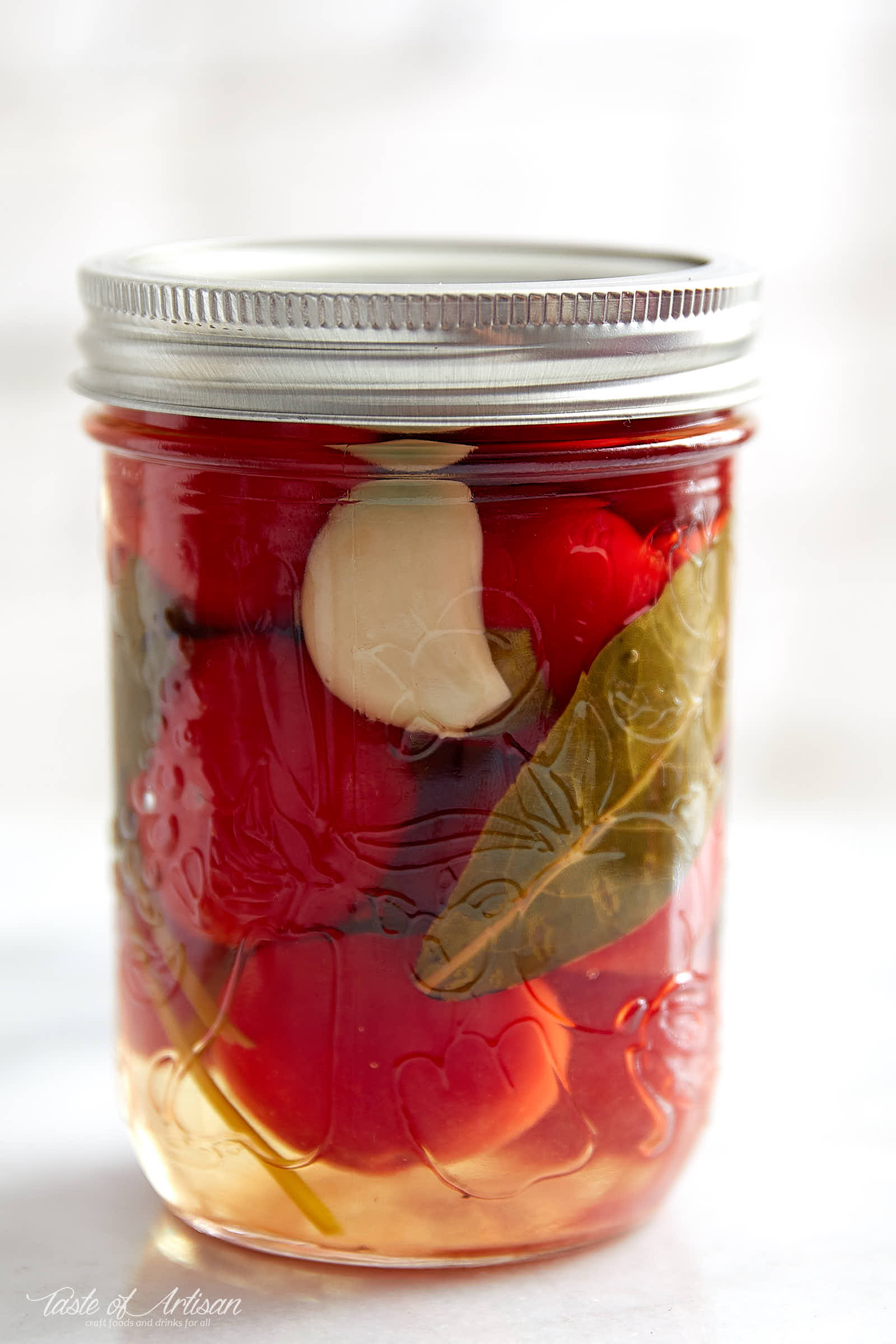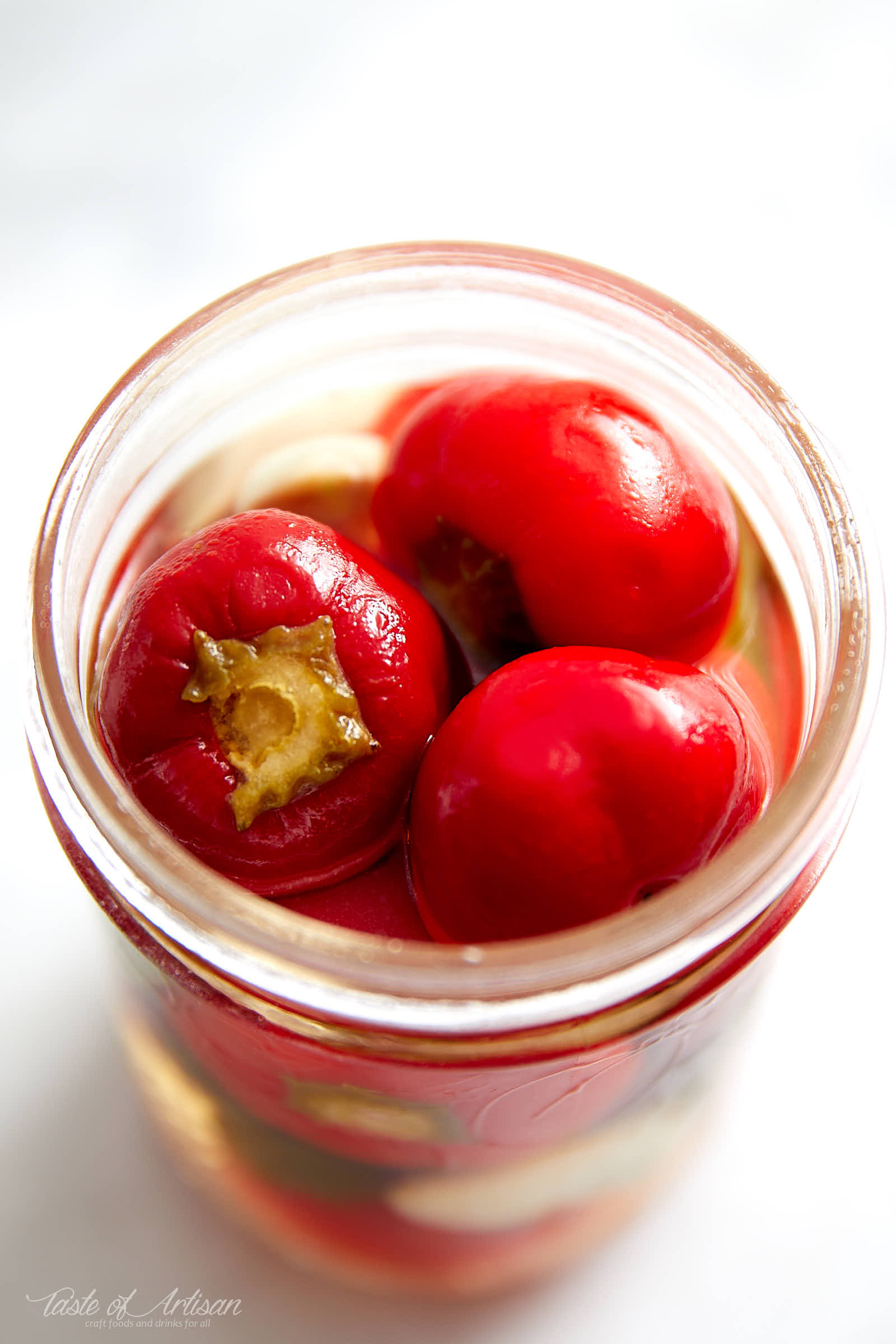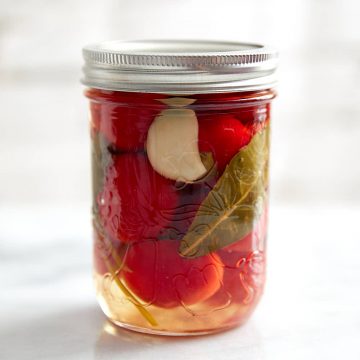
As much as I like pickled cherry peppers, store-bought ones just don't cut it for me. They use preservatives and, above all, tend to be way too sweet. What's the deal with all the sugar? Did someone do a research and establish that sweet pickled cherry peppers taste better? Well, they don't. A savory taste, with just a touch of sweetness, suits them much better. Pickling these little peppers at home will also save you a ton of money.

You can pickle cherry peppers three ways:
- whole, untouched
- whole, de-veined and de-seeded
- cored, de-veined and de-seeded and cut in halves or quarters
Why does it matter? Here is why:
- Whole and untouched look the best of the three. They take the most space in a jar. And they are the hottest due to preserved membranes and seeds.
- Whole, de-veined and de-seeded are not as spicy. They are lightly spicy, actually. Not much space-saving here, just a tiny bit. They are great for making stuffed pickled cherry peppers. Even a simple stuffing such as plain cream cheese or ricotta cheese will make them taste heavenly. There is something about that balance of fat, acidity, spiciness and a touch of sweetness.
- Halved or quartered cherry peppers will allow you fitting in about twice as many in a jar. They are easier to eat as they are bite-size.
How you pickle your peppers will depend on how you want to use them and whether you want them spicy or mild. Some like them hot, some like them mild. Because of that, I usually do a combination.
This recipe is adapted with a couple of small changes from Chez Panisse Vegetables book. As much as I love the original recipe, I find that using white balsamic vinegar produces much better results. The flavours of the two are very similar, although the dark vinegar is slightly sweeter and tends to be more syrupy. White balsamic vinegar has a cleaner taste, which is the main reason I use it. It's also aesthetically more pleasing if you want to show off your pickled cherry peppers. The other change I made is to bump black peppercorns from 1/8 teaspoon to one teaspoon of whole ones.

Ingredients
- 10 - 15 cherry peppers
- 1 clove garlic
- 1 tsp black peppercorns
- 1 small bunch cilantro
- 1 bay leaf
- 1½ cups white wine vinegar
- ¼ cup white balsamic vinegar
- 1 cup water
- 1 tsp coarse salt
- 2 tsp white sugar
Instructions
- Wash and dry the peppers and put them in a glass jar. You can also use any non-reactive storage container. If you want your peppers de-seeded and de-veined, and cut into pieces, do it now. You can mix and match cut and whole peppers in the same jar, or store them separately.
- Peel the garlic clove, cut it in half and add it to the cherry peppers along with the black peppercorns, cilantro and the bay leaf.
- In a small saucepan, combine the vinegars, water, salt, and sugar. Bring to a boil and let it cook for 1 minute. Remove the liquid mixture from the heat and immediately pour over the peppers.
- Let the contents of the jar cool completely at room temperature, then cover and refrigerate for 1 week. The peppers will be ready for eating after 1 week and will store in a fridge for up to 2-3 months.


Heather Gerstein says
Can I use just plain white vinegar for this? Don’t have any white wine vinegar and want to make these!
Victor @ Taste of Artisan says
I think so. The flavor will be just a touch different, but it should work well.
Shannon says
I have been making these pickled peppers for a few years now and they are absolutely delicious! Depending upon the year, sometimes the peppers can be a little more or less spicy but I think the balsamic vinegar does something to tame it a bit. I don’t change anything except maybe adding more peppercorns. Everyone loves them - I use them on salads, pizza, soup and pasta - and they seem to last in the fridge even longer than the 2-3 months. Thanks for a great recipe!
Victor @ Taste of Artisan says
You are very welcome, Shannon. Enjoy!
Janelle Cook says
Can I omit the cilantro or replace it with something else? There's a cilantro hater in my tribe.
Victor @ Taste of Artisan says
Yes, use whatever you like - parsley, sage, basil, dill, or whatever else you like. Make it yours and you will love it. Enjoy!
Ariane says
This recipe was awesome and easy to make! I added a couple of things and omitted the cilantro as I didn't have any. I added extra garlic, changed peppercorns to tablespoons from teaspoons, and added capers and caper brine. They came out amazing. And did I mention this was my very first time making pickles? I am going to make it again with the cilantro! I had also seeded and cored my peppers for future stuffing, so next time I am going to cheesecloth the seeds and add them into the jar for a little more spice.
Victor @ Taste of Artisan says
Glad to hear it, Ariane. May I recommend another recipe? Try my fermented (refrigerator) dill pickles. My family loves them so much that I always wish I'd made more.
Adrianna says
Can you use a canning method for these? I have a huge harvest of sweet and hot cherry peppers and am looking to use them. BTW - your website is awesome
Victor @ Taste of Artisan says
Thank you, Adrianna. To your question, I responded to a similar question below; look for my comment dated September 3, 2021. I follow USDA recommendations. USDA does not have a recommendation for safe stuffed pepper canning, probably because it's hard to do that as stuffings will vary a lot, which will affect processing. The only safe way (per USDA) to can peppers is as described here.
If you look at various resources though, they are all over the place; I've seen people recommend canning stuffed peppers after only filling jars with hot brine which is very unsafe, to hot water bath processing from 15 minutes to 55 minutes for pints and 1 hour 5 minutes for quarts (saw this recommendation in a home preservation book).
Stephanie Harris says
So I had planted red peppers thinking they were the red version of green or yellow peppers. Surprise I ended up with hundreds of hot cherry peppers. This recipe was easy, though I did can them for later use and gifts. I was unable to find white balsamic vinegar, so used regular pickling vinegar and the taste was wonderful.
Victor @ Taste of Artisan says
Glad to hear it, Stephanie. Enjoy!
Kris Spitzform says
Can these jars be processed.?
Victor @ Taste of Artisan says
Yes, but with a caveat. I recently did some research on canning peppers and the only thing that I could find directly from USDA (here is their canning guide) is that you can process peppers as is, with some salt added if necessary, without having to add citric acid or lemon juice as required for canning tomatoes or cucumbers. However, peppers must be processed in a weighted-gauge pressure canner for 35 minutes for pints and quarts at 10 PSI (0-1,000 ft) and 15 PSI (1,000 ft +). The numbers are a little different for dial-gauge pressure canners, you can find them in the guide. However, they recommend roasting peppers, coring and removing skin, membrane and seeds prior to canning.
Old-school books are full of recipes where peppers are canned whole with skins on but the current USDA recommendation doesn't seem to support that approach now. It's because skins are where all/most of the bacteria are so they think it's best to remove them prior to canning.
Dana Meyers says
I was wondering if I could skip the refrigerator part, just taking the jars straight to the pantry for the winter?
Victor @ Taste of Artisan says
It depends on how cold your pantry is. Technically, this recipe is for fridge temperature storage (below 40F). If you want to keep them at higher temps, you'd need to process them differently, I am talking about proper canning. That's if you want to follow USDA guidelines to the letter...
LindaK says
Can I add more whole, de-seeded peppers to the jar as I use the older ones?
Victor @ Taste of Artisan says
Yes, you can. It's a bad idea (unsafe) to re-use the same brine or pickling juice when canning as you want to keep the salt/acidity ratios unchanged. Here, the peppers are refrigerated so we are not as concerned about that. As you add more fresh peppers over time though, the pickling juice will become weaker and you will start noticing the change in taste. That's when you should make new pickling juice.
Pamela says
I guess I'm wondering if this pickled cherry pepper recipe can be processed and sealed in a water bath
Victor @ Taste of Artisan says
Pamela, yes, it can. Please see this resource for processing both pickled and non-pickled peppers.
Michael Blanton says
I noticed you didn’t say what sized jar. Sorry, I’m new to this
Victor @ Taste of Artisan says
That depends on whether the peppers are whole, whole and cored, or cut into pieces, and how tightly you pack them. Also depends on the size of peppers. You will get about 2 pints from 15 whole uncored peppers.